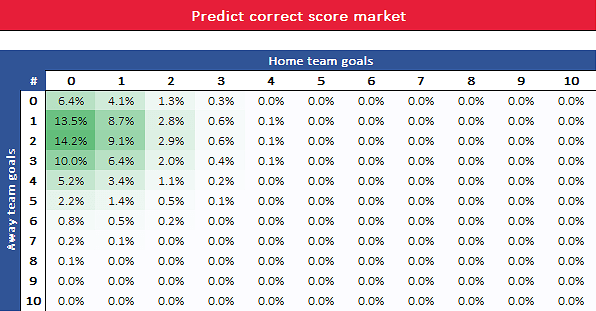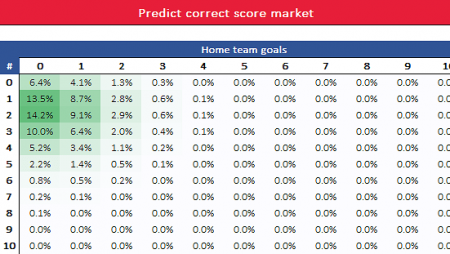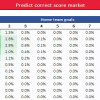

Let’s understand predicting football odds with an easy example. We will take a Home Team (HT) and Away Team (AT) and calculate their odds to find the best odds for betting.
To clear all your doubts regarding how to know winning odds in football?, How are odds calculated in football? or how to use odds to predict football please read the article till the end and get the prediction trick.
Start with finding results of the last 15 matches of both teams
Home Team’s last 15 results of home matches
7 Won; 5 Drawn; 3 Lost
Away Team’s last 15 results of away matches
3 Worn; 5 Drawn; 7 Lost
So, here we have the data to predict football odds of the contesting teams. The next job is to make an equation using the data of the last 15 matches of the contesting teams.
Home Team’s home price:
Add Home Team’s winning matches with lost matches of the Away Team
7 + 7 = 14
Find the draw price:
Add draw matches of the teams
5 + 5 = 10
Away Team’s away price:
Add Away Team’s winning matches with lost matches of the Home Team
3 + 3 = 6
Bring the data to one place for further calculations
Home Team = 14
Draw = 10
Away Team = 6
The next step is to convert these figures in percentage for which you need to divide the numbers by 30 matches
Home Team’s percentage: 14/30 = 46.66%
Draw percentage: 10/30 = 33.33%
Away Team’s percentage: = 6/30 = 20.00%
Now you need to get the right odds for which you need to divide the percentage figures with 100
Home Team: 100/46.66 = 2.14
Draw: 100/33.33 = 3.03
Away Team: 100/20.00 = 5.00
Now you have the final figures of Home Team, Draw, and Away Team odds. Compare those odds with the numbers offered by a leading bookmaker.
Let’s assume that a bookie is offering the following odds
- Home Team 2.20
- Draw 3.30
- Away Team 3.40
Home Team
The bookie is offering an odd of 2.20 but according to your calculation, it should be 2.14. Here the bookmaker is offering a higher value (1.27%) that shows that the Home Team is more likely to emerge victoriously.
Draw
The bookmaker’s odd is 3.30 but your odd is 3.00. Here the bookie is giving an appreciation of 3.03%. It proves that the match has good chances of ending in a draw.
Away Team
You are offered an odd of 3.40 but your calculation for Away Team odd is 5.00. Here you can see a big but negative difference of 9.41% in the odds. It shows that the Away Team is 9.41% fewer chances of winning the match.
Let’s discuss the findings and choose an odd
You have the Home Team winning by 1.27% but the Away Team has a negative value of 9.41%. The Draw result has a value of 3.03%.
The rule of thumb says that you bet on a team that has at least a 5% value of winning. According to this rule, both Home Team and Away Team are kept out of the option.
The second rule says that you shouldn’t bet on a draw until it has at least 1% appreciation. Here the draw result has a 3.03% value hence the right odd to choose
Lengthy calculation
If you want to expand your calculation to make it more accurate, you can take the results of 20 matches of Home Team and Away Team. It will provide you more data to find the right odd. But the rules of calculation will remain unchanged.
Check odds offered by all leading bookmakers
You shouldn’t limit your options to a few bookies as it will shrink your chances of getting the right odd. It is better to check the odds other bookmakers are offering before making an opinion on your findings.
In other words, you should make your data all-inclusive so that you don’t miss a single figure that can change the findings. The math works well for football bets but only when you know how much data you need to predict football odds.
Word of caution
The mathematical formula can give good results but it is never a guarantee of success. You need to look into other factors as well. But the math can help find the right odd you can bet on and enjoy your betting to the full. You can have the confidence to predict football odds with the help of data-based calculations.









